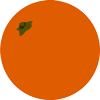Re- View #4: Dazzle Ships
Jamie Sharpe
Jami Macarty & Nicholas Hauck
Advisory Board & Editors
Jami: Commence our fourth Re- in The Maynard’s Views series of reviews!
Nick: There is a lot going on poetically in Jamie Sharpe’s third collection of poetry Dazzle Ships, and I want to get into its web-like structure, but first...
Jami: Pull up on your reins, Nick; your excitement horse has jumped the mark! We have a “first” before “your” first—to extend our thanks to poets Susan Lewis for sending Heisenberg’s Salon (Blaze Vox) and Michael Katz for sending No Turning Back (Thirty Touches Publishing) and to the Canadian publishers who sent us their books to consider for review: Anvil Press, Anstruther Press, Caitlin Press, ECW Press, Gaspareau Press, Goose Lane Editions, (icehouse poetry), Nightwood Editions, The University of Alberta Press, and Wolsak & Wynn (Buckrider). Thank you!
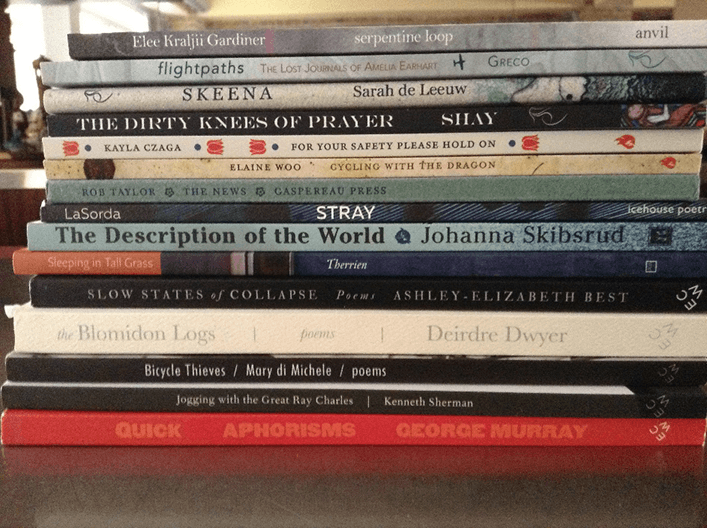
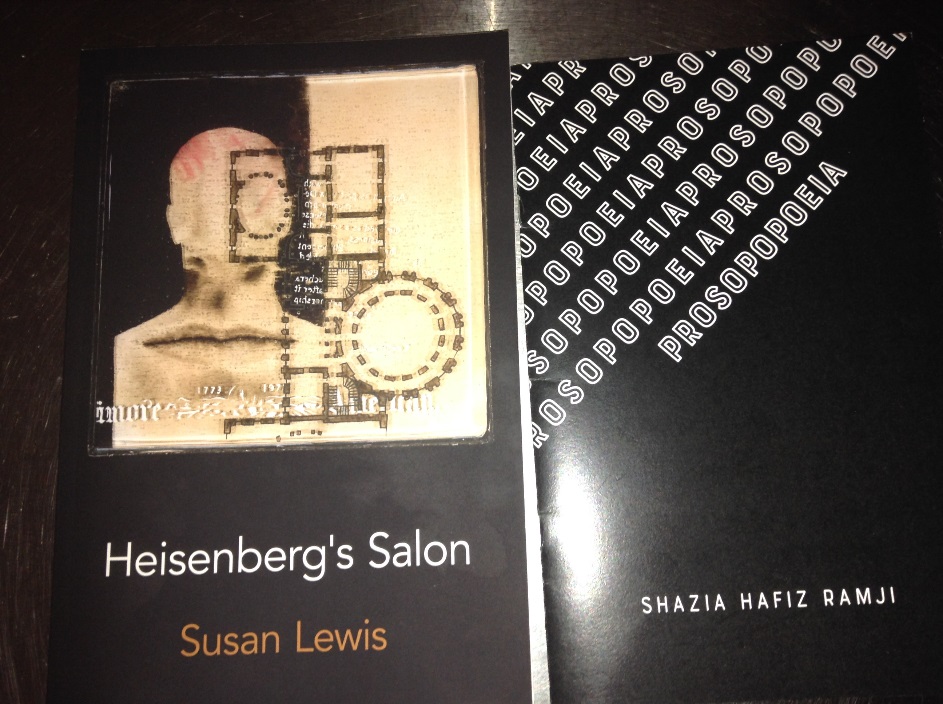
Thank you! to these special poets and publishers for their support of poetry and the Views feature at The Maynard!
As our favorite Robert Creeley would say, Onward!
The book operates on meta- and para-textual levels, borrowing from notes, author bios, reviews, and critical commentary to form its web-like poetic structure.
Nick: I want to say something about the way the book operates on meta- and para-textual levels, borrowing from notes, author bios, reviews, and critical commentary to form its web-like poetic structure. I’m usually turned off by this kind of furtive word play, because it often comes across as pretentious, contrivance meant to trick or distract from—what? Content? Substance? I’m not sure—and that’s probably the point. But Sharpe’s wit, humor, and slick word play make up for (most of the time) and even justify (some of the time) his clever games. The poem, “Can Remember No Poems of Memorable Quality” (63) is one of the gems that draws me into Dazzle Ships’ conversation:
In the critical edition of this book
the editor, an esteemed scholar,
points out the funny bits.
Along with calling out its writer and editor, self-deprecatingly, these lines call out the poem’s own futurity, placing it, and us as readers, in a quantum time of present-past. We’ve been caught in advance!
Jami: “Advance” is compelling here; it points to a concern with the temporal, that for me, informs the ground of the poems. Sharpe uses the metatextual to signify the impact of time on a poet and his poetry—the future. It is also used to pay respect to poets in Sharpe’s personal cannon—the past. While other writers’ intertextual discourse takes place between two authors, Sharpe’s manifests internally—between him and him and between his three texts all within the one text—Dazzle Ships. O! the idiom: “ships passing in the night” just surfaced in my thinking. What are Sharpe’s “ships”? For me, they are the “present” text—the poems in Dazzle Ships—critically commenting on his “past” texts—Sharpe’s two previous poetry collections: Animal Husbandry and Cut-up Apologetic. Having just Goggled, Dazzle Ships, I can share that it’s backed by other references. Dazzle Ships is also the title of a 1983 album by Orchestral Manoeuvres in the Dark (OMD); the album cover, designed by Peter Saville, alludes to the painting by Vorticist/Cubist/Surrealist artist Edward Wadsworth titled Dazzle-ships in Drydock at Liverpool. The title of Sharpe’s book of poetry, the OMD’s album title, Saville’s design, and Wadsworth’s painting all allude to “dazzle painting,” a type of ship camouflage used extensively in World War I. “Camouflage” is an operative word here.
Nick: Yay! In a way, the metatext is both subject and camouflage, and I like the way you put it: the internal metatext. I feel an alternate world is created, one that is eerily familiar because Sharpe’s cannon is recognizable. He’s playing himself, too, which is another reason why I’m enchanted with his word play. As a reader, how do you react to the devices used?
Jamie Sharpe reveals himself as a poet who cares about his reader, who understands some of his readers’ need to be engaged and entertained.
Jami: How does the way Sharpe uses metatextuality/intertextuality transcend the level of cleverness that typically makes readers like me and you feel manipulated? Via camouflage! By changing its customary use, by using it for more than it’s meant for, by literally turning it inward, instead of outward, “to use on” his own texts. That’s a Surrealist move! The Surrealists were all about resisting “rationalism.” That’s what Sharpe’s reacting against—and that’s why I’m turned on! I think Sharpe’s Surrealist ploy honors the cultural and artistic movement as his literary/artistic ancestors and benefactors. As for paratextuality, what can I say—I love show and tell. It makes me believe or suspend disbelief, and it substantiates the poems and their world. An example of paratextuality occurs on pages 40-41. On verso page 40, the poem, “Denmark Pure God’s Grace & The Blessed Orb” opens with the quatrain:
The Bennett Sun commissioned me
to make their album cover
because I’m a friend
and work for wine.
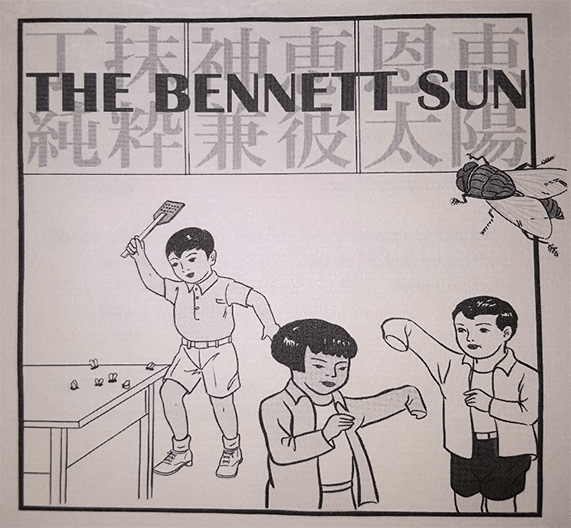
Recto page 41 features the “album cover” design!
That gesture of creating ephemera to support the poems makes me a happy writer and reader. In it, there’s artistic possibility, engaging me such that I ask: how far I will lean on or push my work. And, there’s reader respect; Jamie Sharpe reveals himself as a poet who cares about his reader, who understands some of his readers’ need to be engaged and entertained. This, to me, is very social art, something rare and wonderful in poetry.
Nick: Right! There is an openness and a generosity here that invites us into Dazzle Ships’ helm.
Jami: Nice! So, for me strands of time and types of camouflage, e.g. intertextuality, paratextuality, and Surrealism make up the poems’ “web-like” structure.
Nick: O, right, I wanted to say something about the collection’s “web-like structure.” For me the network of references and devices act together like moving specula, reflecting each other but never in the same way twice.
Jami: Shall we look further into what’s “caught” in the web?
Nick: Yes, let’s start with the collection’s first poem. “Saint Paul in Minneapolis/Clean the Waves Dead Calm” (7) performs like an epigraph and bifurcates the overall structure of the book. The preposition in the first half of the title tells us that Saint Paul is a person, not a city. Shifting/camouflaging the contextual meaning and the grammatical function of words occurs often in the poems. In this particular instance, we’re reoriented toward St Paul, MN with the opening lines: “The Wuollet Bakery/ on West 50th.” So, who’s the Saint? The speaker/author? The reader? “—You!/ My twin!–My Brother!”? I don’t think it’s necessary or even possible to answer that question, but it does set up, for me, the book’s architecture of dualism, doubling, or mirroring.
Jami: Ah-ha! We’ve arrived at another strand in the collection’s web—how, as in this “proem,” what’s “normal” and “expected” from a poem isn’t to be expected in Sharpe’s work. This poem acts “normal,” starting with a title and ending with punctuation, but then also continuing into a second poem, which ends with its own title. All this on one page!
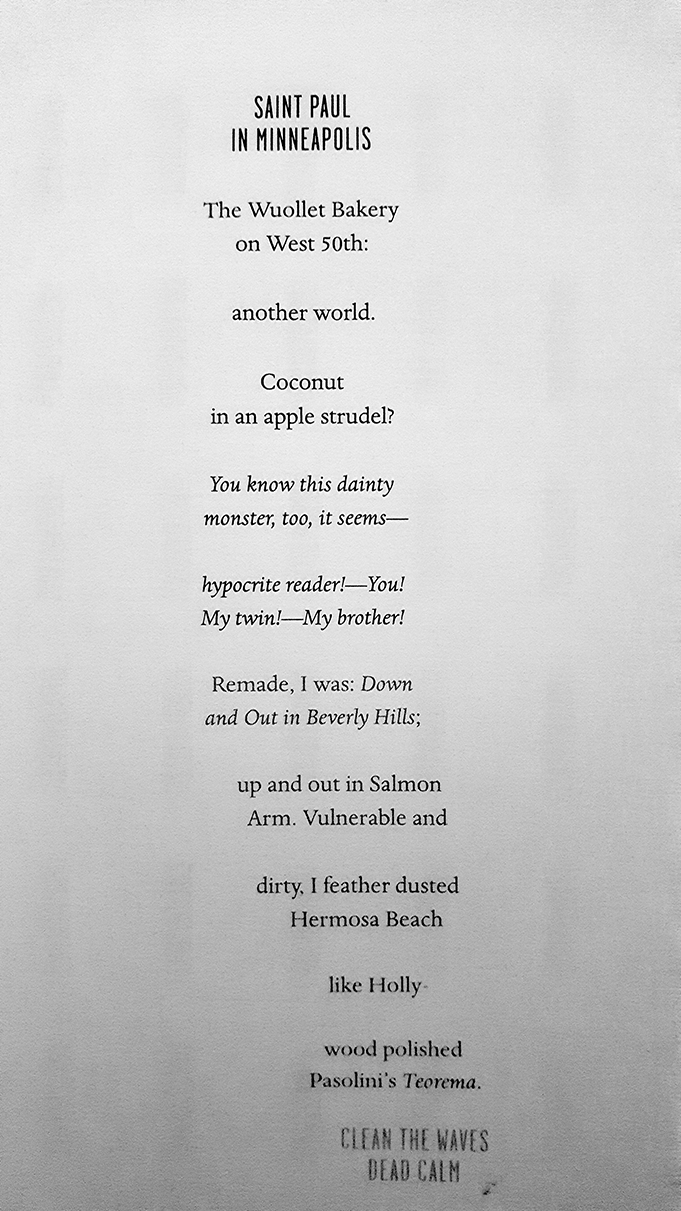
More than the “architecture of dualism, doubling, or mirroring,” that makes me consider “container”—page as, poem as, titles as. So, not of two, but of one—the one that holds and absorbs two. Say more about the architecture you experience here.
Nick: If there is an architecture, it’s fluid, shapeshifting, and yes, camouflaged and camouflaging. “Saint Paul in Minneapolis/Clean the Waves Dead Calm” (7) seems to be in two halves. The second half, printed in a lighter font, is personal: “Remade, I was” versus “another world” in the first half. The “Vulnerable and/ dirty” speaker seems to go through some kind of weak, profane transformation, suggested by the second title. For me, this signals a subtle change in ways of seeing and being in the world. But the dualism is a mirage, the other is the same, or like Rimbaud, I is another.
Jami: By your word choice—“half,” “profane”—I’m sensing your experience of duality within this p(r)oem. What do you make of the place-naming? There’s Saint Paul—both the place, one of the twins called the Twin Cities, and also the person (a twin/ two)—Beverly Hills, Salmon Arm, Hermosa Beach, Hollywood—in this case split (into two halves) and rendered as “Holly-/ wood.”
Nick: I think these geographical markers add a cartography to Sharpe’s web of literary and artistic references. They ground the reader while maintaining the play of two-in-one. So, our feet are planted in a world that’s a bit askew!
Jami: This poem also lays the ground for mathematical considerations which factor (I can pun, too!) into the book’s poems, by referring to “Pasolini’s Teorema.” That’s writer and director Pier Paolo Pasolini and his 1960 art-house film Theorem. The mathematical, I venture, is another strand of the “web.” At the risk of seeming tangential or making more than intended of the connections between the film’s plot and this poem, I’ll offer the possibility that the poem is a mysterious “visitor” (like Terence Stamp in the film) insinuating itself into the psyche of the reader, where it exerts a curious, seductive, epiphanic possibility.
Nick: Wow! You got somewhere that seems right, but is also a rabbit hole… One I would love to go down, but we better stay on course. I want to talk about the book’s last poem, “X On the Score Sheet” (77), which conjures death and other transformative thresholds:
a membrane
one passes through back into
the world...
If the collection is framed by subtle metamorphic experiences, the reader is prompted by both the structure and content of the collection to not dwell, but to act. After all that happens, “We might as well go bowling” (77) is the last line in the book. It wasn’t until I read the final poem that I understood that in its own unique way Dazzle Ships deals with loss, mourning, and memory, but differently than some of the other books we’ve talked about—Kirton’s Page As Bone Ink As Blood or Okot Bitek’s 100 Days. It’s fascinating to see how these poets work through personal memory and collective time in their art. How do you see the poems working through time and memory? Do you think the tone changes the stakes of loss and recovery/resolution?
Jami: With those words and questions, you put me back on the path and help me to get at something I wasn’t sure I’d include here. After reading Dazzling Ships, a sadness, as thick as sea fog (or wildfire smoke in BC) rolled over and debilitated me. I had to get into bed. At first, I didn’t realize the obstructing sadness was my psyche’s response to the poems, because—I’m guessing here—I wasn’t aware of feeling sad while I was reading. I was, I think, engaged, as you seem to have been, with the “web,” with the apparent “cleverness” of the poems (sometimes annoying to me), and with the poems’ “work against.” After laying for a while in the dark in the middle of the day, it hit me that the sadness was in response to the poems; that the sadness had crept in without my notice, until it obscured everything else.
Nick: I didn’t feel the need to lie down (although I probably should have), but I’m with you on the creeping sadness. The after-shock, as it goes, can have a greater effect. In “Unnaturally Balanced” (19), “Earthquakes [are] the new freedom.” Maybe the poems’ work is to shake things up, like a quake, turning loss and grieving into a delayed process rather than a realized event.
Jami: For me, a poetry with the power to affect me is how I know I’m in the presence of Art. Now, to your questions. To some extent, I addressed “time” and “memory” above in my reference to the temporal element—“the past” (memory) and “the future” (fantasy)—of the web. I’ll add that the word “prophesy” is used often in the collection. Two poem titles: “20/20 Prophesy” (12) and “After 20/20” (13) address both past and future by altering/deconstructing the phrase “hindsight is 20/20.” The poem “The Middle Path” (31-33) addresses time via generations and industry—“Super” and “Digital,” “The Hindenburg” and “The Concord”—pointing to family history and technological advancement. On to your doozy of a question: Do you think the tone changes the stakes of loss and recovery/resolution? My sense is that tone reveals the psychological state and stage of grief of the one experiencing the loss. I think the speaker often hides behind the tone in the poems of Dazzle Ships, but that’s not ours to judge or worry about. Grief has its own dominion, and any grace of resolution, its own time. I trust that. So, the tone here doesn’t distract me. Rather, it seems authentic and true to this time in this speaker. This might be a time to describe the tone. Will you take a stab?
Nick: The tone is one of humor, throughout. No one and nothing is immune to it. “Fault Vodka/Blame Juice” (47), published in the Fall 2015 issue of The Maynard, is one, when we read it during the selection process for the issue, that caused us both to laugh out loud. Humor’s used to alleviate and subvert the darker content of Dazzle Ships, like in “20/20 Prophesy” (12):
The day of the pink cross
pregnancy test I lugged our cat
into the alley and shot her
with a Super Soaker.
“A Frequently Occurring, Shared Condition We Know Little About” (67) is a hoot, from:
Everyone’s subjective existence,
like not having porridge
on your kitchen table
because you can’t afford a kitchen table.
to:
Didn’t write the book
so much as dream it into
our syllabus.
Or you were the dreamer—
if so, where are my pants?
Even Sharpe isn’t spared from the joke, which is what makes these poems so appealing to me. And he pulls off the artistic stunt extremely well. Difficult thing to do!
Sharpe’s use of humor and associated self-deprecation feel natural, unforced. To me, that gets him most of the way toward earning my trust. Humor also allows Sharpe to pay further homage to his predecessors.
Jami: There’s much we could say about Sharpe’s use of humor—how hard it is to pull off in writing, maybe especially poetry. Sharpe’s use of humor and associated self-deprecation feel natural, unforced. To me, that gets him most of the way toward earning my trust. Humor also allows Sharpe to pay further homage to his predecessors. His humor points to Shakespeare, who’s both mentioned and referenced within the poems, and also to Jack Spicer, Joseph Brodsky, Ken Babstock, and other apparent whimsical apparitions in these poems. I’m thinking here of the New York School poets, first generation John Ashbery and Kenneth Koch, and second generation Dean Young.
Nick: Also, Milton and his Pandemonium. So, there is an awareness of community, to being affiliated, and wanting to be connected that seems genuine. Not that the humor isn’t… Let’s look at another poem that uses humor. “The Middle Path” (31-33) is also one of my favorites. It lightly, cleverly, humorously asks heavy questions about authentic poetry, relationships, and identity, especially identification with/to the self. The self-referential tone of the texts catches us, again, with the line “I’ve designed this for success in that it can only be read/ one way” (31). This line, along with “You thought this poem/ was man-made, too?” from “Chatterbox” (34), and the “online kanji tattoo generator” from “Denmark Pure God’s Grace & The Blessed Orb” (40), intensifies this poet’s hyper-awareness of agency in the creative process. How does the automation suggested in the lines above change the poet’s job? Does it force the poet to work in different ways? If so, he’s having fun with it, and if life is art, shouldn’t it also be fun? Maybe this is the mezzo referenced here and also suggested by the structure of the book? But again, any overdetermined response is thwarted, because “symmetry [is the] laziest of beauties” (31).
Jami: Does automation change the poet’s job? Not this poet, Jamie Sharpe! This poet uses automation and technology as subject, uses the lexicon from these spheres, and makes a virtue of automation as compositional mode. Does it force the poet to work in different ways? Depends on whether or not the poet works against or with “automation.” This poet, Jamie Sharpe does both, making much of opposites and opposition. How’s that possible? I don’t know because I am not Jamie Sharpe! Another way to answer that: Surrealism. Surrealism is how that’s possible. Sharpe employs the notion of chance, extolled by the Surrealists. He plays with the super-real, the conceptual, and seems wholly given over to the generative process, using everything, especially literary devices, as prompt or constraint toward a poem. That’s the territory of the Surrealists and that’s devotion to the poem, first and foremost. You feel that, right—how the poem, not the poet, comes first for this poet?
Nick: I do. There’s the famous line from Lautréamont that the Surrealists used as pseudo credo: a chance meeting on a dissecting table of a sewing machine and an umbrella. Sharpe updates the metaphors with cinema (montage as sewing images) and copy (Xerox), privileging the material of the poem/poetic process, whatever that may be. There’s a poetic potential that Dazzle Ships reveals in the contemporary (automated) world.
Jami: “Contemporary,” yes, these poems are utterly of the 21st Century, and of all that preceded, i.e. the Surrealists. I have to point out that Surrealism began around 1920, just two years after the end of World War I during which dazzle camouflage was used. There’s that relationship to time and history again…
Nick: The book often challenges different kinds of relationships, those with others (family) and the self, as in “The Middle Path” (31-33):
I’m falling in love with myself (slowly) but want to see
other people.
The negotiation between self and other recalls the broader theme of the reliability of appearances and their legitimacy. What does it mean to write about authenticity when we know that language is camouflage(d) too? Fleeing from the issue is both suggested and mocked in the following lines, also from “The Middle Path” (31-33):
When I enter the gym, which is to say my feelings,
I hit the treadmill (my tendency to run from
conflict).
But for me one of the most alluring aspects of Dazzle Ships is how word play and enjambments recycle conflict and seesaw with humour.
Jami: Yes, always with humor. Nothing, especially writing poetry is taken (too) seriously. Sharpe plays with “the obvious,” pointing out the absurdity in our lives. He’s also doing something that’s sly here, poking at the self-absorbed, solipsistic “selfie” culture and the particular angst defining the 21st Century. The futuristic web in these poems also helps reveal chaotic brambles of absurdity and complexity.
Nick: Familial relationships extend along similar strands. In the terrifically titled “Before Dad’s Cookies, Papa’s Chocolate Dunk Brazilian (21), misunderstanding is absurdly explained away:
Some poems are edited
from existence for the same reason
Dad’s treatise on body hair
didn’t make the fondue cookbook.
And in “The Engagement” (15), intergenerational conflict between men is ridiculed in both parties:
My great-grandfather installed screen doors
on submarines. This said by my grandfather
who hated the generations directly before
and after himself. I’d blame the lack...
I mention conflict between men, because there are noticeably fewer women in the poems, or when there is mention it seems to be in a very distanced, objective voice. I’m thinking of the poems closer to the end in particular: “I Have Fantastic Luck With Engaged Women” (72), “In The World Of Sexy Hunger” (73), “Manly Obscenities or Feminine Hyperbole?” (75), and “Ain’t No Shorty Wear Those Sorry-Ass Bowling Shoes” (76). Even the sister in “Sorry About Sis, Dad, But The Photocopier Won’t Collate Properly” (64), feels disregarded. What do you make of the role and place of women in these poems? Do you feel a difference in the way that men and women are treated?
Jami: O dear! I don’t want to go there, but I must! I also noticed this disregard for, insensitivity toward women. I think Sharpe might say, nothing is saved from humor’s chopping block. I think we’re saying that as we consider his use of humor along with his treatment of women, we find fault and failure. Why is that? Perhaps because the poems don’t provide enough dimensions of women?
Nick: It’s disconcerting that women are the only “other” the speaker in these poems discounts. That discount is indirect; I fear it may even be unconscious. If so, it’s unfortunately the same old, tired, infuriatingly misogynistic ground we’re working to eliminate in art and the world. What do you think is being said about affiliation and connectedness to the other? I ask because there are also more direct stabs at CanLit poetry and its players, like in “Special Economic Zones/Rush To The Middle” (46), where editor and journalist Jared Bland is quoted questioning a Writers’ Trust of Canada poetry prize and then parodied:
Canada’s mid-career poets fall in an inverse bell curve:
The bulk being geniuses or imbeciles. There is no middle.
The need to editorialize over news.
New literary award: good
- Too bland.
New literary award: good (but are we good enough for it?)
- Super Bland™!
Jami: While I feel the poems’ treatment of women as the insult that comes with disregard, I feel humor as veiled distain for Jared Bland in “Special Economic Zones/Rush To The Middle” (46). Bland is being evaluated as a book editor or contest judge might evaluate a manuscript as worthy or not. Sharpe’s taking on the publishing industry, the editors, the deciders (Bland) is an act of courage, especially given the turmoil within CanLit lately (maybe another time). Here, he’s also poking fun at the thinness of associated perceptions and myths, especially related to poetry, and who decides what has value. Smart. Now, once he really stands up for women, he’ll be my hero!
Nick: Staying with “the other,” but abstractly and in terms of the gaze, “Not Immune Until Infected” (58) is another poem that stands out. It distills one of the themes in the poems: the unsure transitions between what is seen in life and what is (re)presented in art, and the stakes of “looking.” The first line, “Movies projected upon blank screens,” catches me off guard. Of course the screens are blank! So, why say it?
Jami: That’s one of those obvious statements I noted above. The obviousness of our lives is absurd…
Nick: Right. The third stanza carries the metaphor of cinematic projection onto the human body, referencing the title, with “chicken pox on a twelve-year-old/ girl’s face. At seventy-six, the encore:/ shingles” (58). Is affliction just an image? Is everyone, including ourselves, an empty canvas (“cubist painting,” “pointillism,”)? That seems too tired and clichéd.
Jami: Or, does it seem obvious? And, with that, we’re back to: why say the obvious? Indeed, why? The obvious is true/truth. Maybe your obvious, isn’t mine.
Nick: Staying with this poem, if “film […] is anachronistic” and “your pox’s outmoded” (58), there seems to be an implicit relapse in perception that calls into question basic structures of the (observed) world: a multidimensional reassembly of geometric forms? An infinite number of points forming patterns? “Light sensitive gelatin emulsion?” (58). All valid, all inadequate. So where does this leave the body?
Jami: Questioning perception and reality is some of the big work these poems do. I’m thinking here of “The looking-glass self,” the socio-psychological concept introduced by Charles Horton Cooley, who stated "I am not what I think I am and I am not what you think I am; I am what I think you think I am.”
Nick: Ha! That’s great. Even a technically enhanced, magnified optics still leads to “not/ knowing if you were going or here/ to stay” (58). Closer and more detailed observation does not equate to knowing more. The camouflage just becomes more present. There are a lot of cinematic references in the poems (directors, films, equipment), what do you think is going on here in terms of the relationship between image and language?
Jami: Yes, to: “the camouflage just becomes more present”! The more Sharpe, and maybe any writer, “tries” to get language to reveal, the more language threatens to obscure. It’s like that adage, point to the sky and it disappears… what reveals itself is the pointing, or “the camouflage.” The connections and differences between verbal and visual languages is also foregrounded.
Nick: On image and language… “Denmark Pure God’s Grace & The Blessed Orb” (40) is accompanied by the image referenced in the poem. After the first poem, there are two pages of design which come back on pages 60-61, dividing the two halves of the collection. In “Fearsome Return” (59), the last poem before the section break, we read:
Dreamt I was playing
doubles. It was just you,
the ball, and a wall.
In the first poem after the break, “Nothing Else From The Period Possesses Such Impassioned Tonality” (62), the game of mirrors is picked up again, but almost broken:
I salvaged its fragile form.
Here, music briefly becomes the uncertain mnemonic medium. Where does that leave words, writing, poetry? The poem’s fourth stanza seems to rebuke them:
I think like a leaky ballpoint
absent-mindedly put it the mouth,
my knowledge limited...
Jami: There’s also the author photo, which takes up a full page in back of the book, but is not “back matter,” as it typically is in other books, but actually Dazzle Ships’ last gesture.
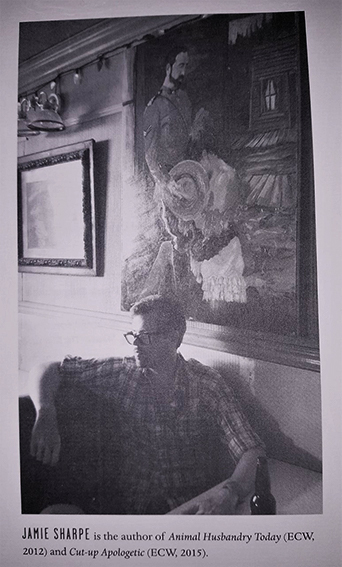
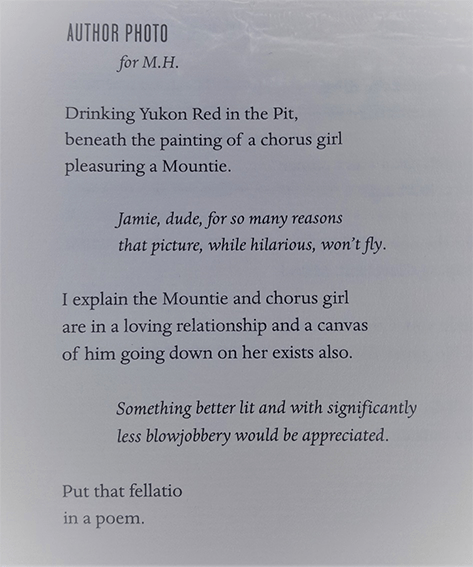
The author photo points to the poem, “Author Photo” (20).
The poem’s opening tryptic, also references the painting in the author photo and the poem:
Drinking Yukon Red in the Pit,
beneath the painting of a chorus girl
pleasuring a Mountie.
In the poem’s next few lines, there’s some awareness of the pejorative treatment of women:
Jamie, dude, for so many reasons
that picture, while hilarious, won’t fly.
However, Sharpe seems to be under the impression that the device of including another speaker’s caution mitigates his seeming misogyny.
Nick: It doesn’t work.
Jami: In the case of the examples of the author photo and album cover, each does something different with the concept of paratextuality. One with words, the other with image, plays with differences in artistic languages. The treatment of women seems to sing one note; unfortunately, it’s the same note society tends to sound, discounting women, whether directly or indirectly.
Nick: Insult is a risk of the tongue-in-cheek. Giving unwanted advice is another, as in “Half Jacks On The Dance Floor” (57):
...Put down
your pen at better parties.
The myth of the poet,
not poetry, is the product
But this treatment is different than that of women. One laughs at the human tendency to glorify persona and status. The other is a put down, which reveals that women are being spoken down to.
Jami: Yes, the poet is myth, the poetry is not, and poking fun at human tendency is different from the insulting human females. When does humor turn insult?
The poems in Dazzle Ships definitely force the reader to question the limits of humor, and that’s the book’s political dimension.
Nick: It’s so interesting, right, where that line is. I’m not entirely sure, but the poems in Dazzle Ships definitely force the reader to question the limits of humor, and that’s the book’s political dimension. I’m also wondering about the personal references in the poems, those that play with the meta- and para-textual elements of being a poet and publishing. The most obvious example is “Cut-up Apologetic/Animal Husbandry Today” (27), mini reviews of Sharpe’s two previous books.
Jami: I see the poem “Cut-up Apologetic/Animal Husbandry Today” (27) in relation to and following similar themes to “Special Economic Zones/Rush To The Middle” (46) and others in the collection. As we’ve said, no one or thing is off limits. Not even Sharpe himself. Sharpe’s review of Sharpe is another example of how this poet addresses perceptions and roles. I consider this poem a result of a Surrealist-type game/ constraint. Along with role-playing and Surrealist games, it also plays with time. What happens to the poems when a review is written, which necessarily takes place after the writing?
Nick: Another example that comes to mind is “Endnotes” (10-11), ten explanatory notes on pieces not included in Dazzle Ships.
Jami: “Endnotes” is interesting compositionally, but also because of its position at the beginning of the book, the first poem after the proem. Instead of being isolated as an addendum to the poem, it is a poem! That sums an integral part of Sharpe’s aesthetic for me. The work seems to ask: what is a poem and where does it start and end? Then, as answer, he says: Everything’s a poem or can be! Also, there’s the question: by what rules are poems made. “Rules, schmools,” I can hear Sharpe reply, poems have no rules.”
Nick: There are subtler examples, too. This hilarious line, from “Manly Obscenities Or Feminine Hyperbole” (75), sums up much of what I feel is going on in the book:
The author used quotations
to let you know he knows
these words are untrue—but not
untrue enough not to say them.
And that’s the point! In this, one of the last poems, we get as much a sense as we’re going to, I think, of Sharpe’s poetic project: navigating life’s catastrophes doesn’t foreclose having a good time, and poetry, because of the way it can play with the meaning of words and language’s form, is an ideal uniform for the game. Bowling anyone?
Jami: Now there’s a title that reveals the gender roles and bias alive and well in the patriarchy, and to some extent in these poems. But, O, when are words untrue enough to not say them? That’s another/’s poetry. This is Sharpe’s, a poetry that privileges humor and play, two of the artist’s truest tools. I have never been bowling and I hope never to go bowling! I wear a bowler hat, though...
